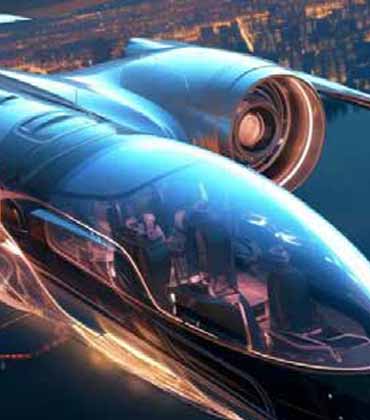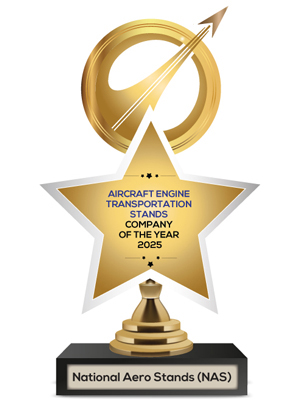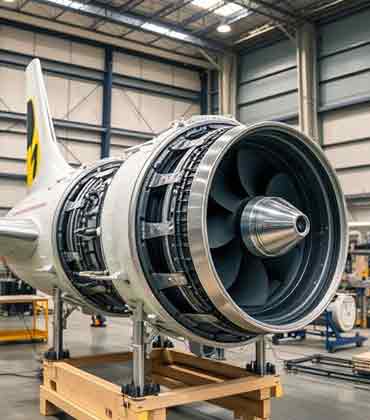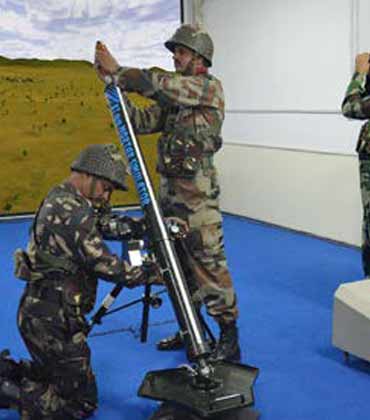THANK YOU FOR SUBSCRIBING
In the highly specialized world of aviation, where precision and reliability are paramount, National Aero Stands (NAS) has established itself as a trusted leader in the Aircraft Engine Transportation Stands (AETS) space. In 2016, National Aero Stands purchased Stands on Demand (founded in 2010) and grew rapidly by addressing a critical industry need: providing flexible, cost-effective access to high-quality engine transportation stands. Today, NAS supports airlines, MROs, and engine leasing companies worldwide, offering innovative solutions that eliminate the complexities of engine stand ownership. NAS was born from a simple but powerful realization: the aviation industry needed a partner solely dedicated to engine stand leasing. While some companies offered stands as part of a broader range of services, none had truly specialized in meeting this specific need. “Our founder saw an opportunity to fill that gap by creating a company that not only provided well-maintained equipment but also offered expert technical support and comprehensive services,” says Gail Holguin, COO of National Aero Stands. “That vision has driven our company’s success over the past decade, allowing us to grow from a small operation into an industry leader with a global presence.” Offering Tailored Solutions A key factor in NAS’s success is its ability to provide tailored, customer-centric solutions. Unlike companies that focus solely on selling equipment, NAS offers a leasing model that is both flexible and cost-efficient. For airlines, MROs, and engine leasing companies, this approach eliminates the need for significant capital expenditures and reduces the operational burdens of owning engine stands. Instead of dealing with storage, maintenance, or asset depreciation, customers can simply lease the equipment they need, exactly when they need it.
Top Military Simulation Solutions Providers
Success in the defense and military sectors is a constant balancing act, relying on strategic foresight and the agility to respond to ever-changing challenges. Survivability in tactical scenarios hinges on readiness and how wellequipped warfighters are to tackle every possible challenge. Here, custom military simulations are critical in preparing soldiers to face the unexpected with confidence. Ternion, a creator of a custom simulation development framework, recognizes that military modeling and simulation (M&S) users have distinct and evolving needs. As Brad Spearing, co-founder and president of Ternion, puts it, “Custom simulations aren’t just a preference but a necessity. The military needs custom simulations that are immersive, precise, adaptable and designed to replicate the complexities of modern warfare.” Yet, building these custom simulations requires big-ticket investments and outdated software can quickly tip the scale toward inefficiency, obsolescence and wasted resources. Ternion emphasizes that flexible, modular software frameworks are the way forward and has built its flagship product — FLAMES — to address these challenges. The well-defined class hierarchy and development tools simplify the creation of specific software classes, reducing complexity and minimizing code requirements. FLAMES accelerates the simulation creation process and overall efficiency by eliminating unnecessary coding and streamlining essential development. Its off-shelf offerings, such as a scenario editor, after-action review and scenario database for managing scenario data, lay the groundwork for developing simulations. In addition to its core simulation capabilities, it offers advanced features such as checkpoint restart functionality, improved analytical tools, and collaborative database editing features. FLAMES also integrates Unreal Engine to create cutting-edge 3D graphics for simulations. These tools, coupled with an integrated interface to Distributed Interactive Simulation (DIS), High-Level Architecture (HLA), and support for CIGI compatible image generators, make FLAMES compatible with a wide range of training needs.
TRU Simulation + Training is a leading American manufacturer of flight simulators and training devices for civil and military markets. In an industry where precision, safety, and technological advancement are paramount, the company has established itself as a leader in highfidelity flight simulators and cutting-edge training solutions. It provides state-of-the-art simulation technology to civil and military aviation sectors, ensuring pilots receive the most realistic and effective training. With a strong emphasis on virtual reality (VR) systems and next-generation training devices, TRU Simulation + Training is redefining the future of pilot instruction. Its industry-leading training devices, programs and support are fueled by the legacy of TRU Simulation + Training’s parent company, Textron Inc. (NYSE: TXT), a Fortune 500 name known for Bell, Cessna®, Beechcraft®, Hawker® and Textron Systems. This affiliation gives TRU Simulation + Training unparalleled access to resources, industry expertise, and technical capabilities, allowing it to develop high-quality products that meet the rigorous standards of modern aviation. At the core of TRU Simulation + Training’s success is its ability to develop highly realistic, cost-effective training solutions. Specializing in full-motion flight simulators and advanced training systems, the company serves a wide range of aircraft, including business jets, commercial airplanes, rotorcraft, and military platforms. TRU Simulation + Training’s FAA Level D certified simulators—the highest standard in the industry—are used for training on aircraft such as the Cessna Citation Longitude. These simulators allow pilots to train in environments closely replicating real-world flying conditions, enhancing safety and operational readiness
CXO INSIGHTS

Supporting Sustainability in Aviation
Bonny Simi, President of Operations, Joby Aviation(NYSE: JOBY)

Airport Management Innovations: Navigating Challenges Effectively
Abe Weber, Airport Director, Appleton International Airport

Strategies for Success and Safety in a Thriving Airline Industry
Alfonso Moreno-Santa, Director of Operations, PrimeFlight

Unveiling Automated Maintenance in Aviation
Robert DeGrie, Director of Technical Services (Aircraft Engineering), Amerijet International

Future-Proofing Airport Safety: Intersection of Innovation, Regulation and Leadership
Travis Krabbenhoft, Director of Airport Safety & SMS Manager, Denver International Airport
IN FOCUS
EDITORIAL
Pioneering Innovations in Defense Simulation and Aircraft Logistics
The defense industry is increasingly prioritizing sustainability in military operations, particularly in simulation-based training and aircraft logistics. A key focus is integrating sustainable technologies into military simulation systems and developing eco-friendly aircraft engine transport solutions. Military simulations play a crucial role in reducing fuel and resource consumption, minimizing environmental impact, and enhancing energy efficiency. Recent innovations in this field include cloud-based platforms, artificial intelligence (AI) and machine learning (ML), virtual and augmented reality (VR/AR), and simulation centers powered by renewable energy. Sustainable aircraft engine transport solutions are also transforming military logistics. Modern transport systems incorporate lightweight composite materials, modular and reusable designs, electric and hybrid transport vehicles, smart monitoring with predictive maintenance, and environmentally friendly packaging materials. The U.S. defense sector is expected to see continued investment in sustainable military simulations and aircraft engine transport systems, with advancements in hydrogen-powered ground transport, AI-driven logistics optimization, and next-generation simulation software. Collaboration between the military and private industry will be essential in driving innovation and ensuring sustainability remains a central component of defense strategy. This edition features National Aero Stands (NAS), exploring how sustainability in military operations is an environmental consideration and a strategic imperative. The magazine also includes insights from Marcus Reynolds, Program Manager, Training Systems, Marine Corps Systems Command, and Duane Cornella, Sr. Manager Operations Control Centers at Panasonic Avionics. By adopting eco-friendly simulation technologies and sustainable aircraft engine transport solutions, the defense industry can reduce its ecological footprint while maintaining operational effectiveness and long-term resilience. We hope these valuable insights from industry leaders featured in this edition will assist you in making informed decisions for your businesses.

However, if you would like to share the information in this article, you may use the link below:
https://www.aerospacedefenserevieweurope.com/edition/march-2025-23.html




![NATIONAL AERO STANDS [NAS]: Elevating Excellence In Aircraft Engine Transportation NATIONAL AERO STANDS [NAS]: Elevating Excellence In Aircraft Engine Transportation](https://www.aerospacedefenserevieweurope.com/newstransfer/upload/12-73zp1-.jpg)






